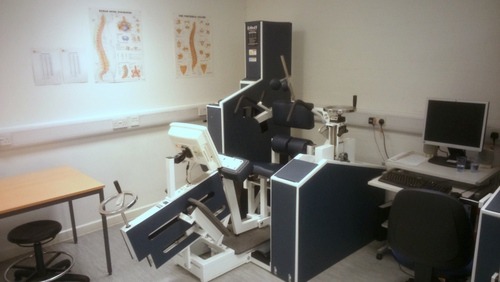James comments on his research and his experience publishing with us.

PJ: Can you tell us a bit about yourself?
JS: I’m currently a Lecturer in Applied Sport Science at Southampton Solent University in the UK. I teach on the Exercise Physiology and Biomechanics units within our degree programs. A lot of my time however is based around research with particular interests in resistance training, its effects upon a range of outcomes and within different populations, in addition to the manipulation of variables within resistance training interventions. I’ve actually just completed my PhD examining the application of a specific resistance training intervention to target the lumbar extensor musculature in sufferers of chronic low back pain.
PJ: Can you briefly explain the research you published in PeerJ?
JS: The combination of interests in resistance training and low back pain led to the research published in PeerJ. We had previously reviewed the literature around low back pain and found some support for deconditioning of the lumbar extensor musculature to be involved both prospectively and cross sectionally. This led us to examine exercise approaches best suited to condition that musculature and subsequently a number of studies examining the use of isolated lumbar extension resistance training in participants with chronic low back pain. However, being that there appeared to be some prospective relationship between lumbar extensor deconditioning and development of low back pain, in addition to evidence that resistance training is particularly good at injury prevention, we wanted to look at applying this to asymptomatic individuals. The manipulation of resistance training variables for producing the greatest improvements in muscular strength has been examined in part for isolated lumbar extension resistance training, however, only one study had examined the role of set volume and had also used untrained participants. As the effect of resistance training variable manipulation may differ for trained participants, and that trained populations are potentially interested in optimal application of approaches to reduce low back injury and pain, we wanted to examine the role of set volume manipulation of isolated lumbar extension resistance training within a trained population.
PJ: Do you have any anecdotes about this research?
JS: I think a great deal of credit should go to my co-author Adam Fitzpatrick as he collected the data for this study as part of his undergraduate dissertation. I think he’d agree it was particularly interesting (and I’d hasten to add slightly amusing) to see the acute responses for many participants in the 3 set group. The training itself was very hard as participants were to perform it to momentary muscular failure. The participants were well experienced and really pushed themselves to their respective maximums in training. Adam took the participants through the training sessions and it was amazing to see how the 3 set group had quite drastic acute responses with respect to nausea. It was something we felt also worthy of discussion in the paper. Especially as there was no difference between 1 and 3 sets, only the truly masochistic would see the additional acute effects of the 3 set approach as being desirable.

PJ: What surprised you the most with these results?
JS: I think the most surprising result was that the control group actually lost strength over the short intervention period. We discuss potentially why this might be in the paper – perhaps their engagement in other exercises previously may have been maintaining their lumbar extensor strength and stopping them during the intervention resulted in a reduction. Nonetheless it was still unexpected and yet I think it perhaps adds emphasis to the importance of specific training for this musculature.
PJ: What kinds of lessons do you hope the public takes away from the research?
JS: I hope the main take away for the public from this research is that it is possible for even trained persons to produce improvements in their lumbar extension strength with very little exercise when using a very specific isolated approach. Many think that higher volumes produce greater adaptations, however, with more recent studies in this area including ours I think the issue is still up in the air. That optimal results might be afforded with a relatively low volume approach however is a refreshing concept and allows potentially more time to be spent on other aspects of training.
PJ: Where do you hope to go from here?
JS: We are currently working on a number of other studies, some related to our work with isolated lumbar extension resistance training, and others that are more general to resistance training. In particular we are looking to conduct research that will enable us to produce and validate a predictive tool for identifying participants with low back pain who are high responders to isolated lumbar extension exercise prospectively. This might allow practitioners to prescribe this exercise to those who might benefit most. We are also looking to examine the effects of specific loading through lumbar extension exercise upon the intervertebral discs. Loading through resistance training produces adaptation in a number of tissues (muscle, tendons, bones) and so it seems plausible that adaptation in the disc might also occur. However no one has examined this through implementation of an intervention.
PJ: If you had unlimited resources (money, lab equipment, trained personnel, participants, etc.), what study would you run?
JS: Wow, that’s a tough question to answer. In fact I have a few different studies based upon my interests I would like to conduct if given unlimited resources. Firstly, to be able to conduct the studies described above to a scale that allows greater understanding of their clinical application than might be afforded by small sample studies. Secondly, I also have interests around the range of outcomes possible from resistance training when performed to a sufficient intensity of effort, particularly the aerobic/cardiovascular adaptations. Unfortunately most studies examining this have been small sample sizes and not particularly well controlled or compared to other more traditional exercise approaches. I’d love to be able to examine this further as I believe it has considerable implications for widening participation in exercise. Finally, and along these lines, I’m very interested in wider engagement in resistance training from a public health perspective. We have conducted some preliminary pilot trials examining the efficacy and effectiveness of an unsupervised bodyweight resistance training interventions for sedentary adults. With unlimited funding I’d love to systematically study the effects of different factors upon adherence to such a program in order to identify firstly whether it is indeed effective and secondly what the minimum support required is for it to be efficacious as an exercise recommendation from a public health perspective.
PJ: Why did you choose to reproduce the complete peer-review history of your article?
JS: I and my colleagues have had mixed experiences with peer review. Some good, some bad. I’m a huge believer in transparency for readers of my work so being able to see the process it underwent prior to publication enhances this. I also think that making the peer review record available offers the reviewers themselves recognition for their hard work towards making this manuscript a success. It also serves as a bit of deterrent for some reviewers feeling they can make unjustified criticisms whilst hiding behind anonymity. It creates personal responsibility for both parties – authors and reviewers – and I’m fully supportive of it as an approach. In fact I’d advocate that all journals should opt for an open peer review system such as used by PeerJ.
PJ: How did you first hear about PeerJ, and what persuaded you to submit to us?
JS: I first came across PeerJ a few years ago through Twitter if I recall. I’ve been a big OA proponent for some time and also as noted am very supportive of the system through which PeerJ operates. However, up until now I had found that it was difficult to persuade some of my colleagues to give it a try with a submission. When a peer published his recent study with PeerJ I mentioned to him that I was impressed to see some exercise scientists publishing with the journal. He subsequently got back in contact with me offering some voucher codes for submission which were the tipping point for me. Taking the lead on this paper I made the executive decision to submit to PeerJ and am glad I did.
PJ: Do you have any anecdotes about your overall experience with us? Anything surprising?
JS: Actually I didn’t find anything really surprising as I had heard such good things about PeerJ prior to submission. In fact the experience pretty much validated them. I’d say the only thing that caught me by surprise was an apologetic email for the review process taking slightly longer than expected – by this point it hadn’t even been in review 4 weeks! Compared with some submissions to other journals that at the extreme had been under review for over a year with no contact from editors I must say I was impressed with this care from the editor. PeerJ did make me feel like a valued customer.
PJ: How would you describe your experience of our submission/review process?
JS: Without being too repetitive I’d have to say the system was very intuitive and user friendly. The staff were open and communicative. The reviewers, were polite and constructive. Overall the journal claimed a particular service and promptly delivered on my expectations.
PJ: Did you get any comments from your colleagues about your publication with PeerJ?
JS: All of my co-authors were thoroughly impressed with the service from PeerJparticularly the speed with which to reviews were obtained and decisions made.
PJ: Would you submit again, and would you recommend that your colleagues submit?
JS: Without a doubt. I already have a few studies I think would be well suited to submit to PeerJ and I’d like to continue to support its development.
PJ: In conclusion, how would you describe PeerJ in three words?
JS: Open, swift, revolutionary!
Join James Steele and thousands of other satisfied authors, and submit your next article to PeerJ.
